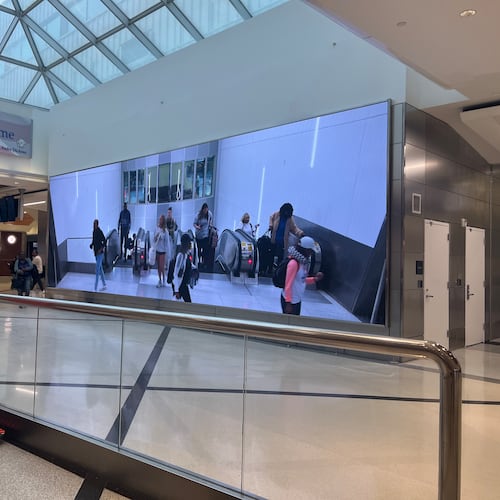Hartsfield-Jackson International Airport is getting $40 million from the federal government to widen Concourse D — one of the most crowded and cramped areas of the airport, as part of a round of grants to airports nationwide from the bipartisan infrastructure law.
The Biden administration announced Thursday nearly $1 billion of funding for airport terminal upgrades across the country from the $1.2 trillion bipartisan infrastructure law. It’s the first round of grants out of $5 billion allocated for the Airport Terminal grant program over five years.
The first round of grants will go to 85 airports nationally, including Hartsfield-Jackson, and they are aimed at improving travelers’ experiences, improving access for people with disabilities and increasing efficiency in the years ahead.
The Atlanta airport plans to use the money to help pay for the expansion of the Concourse D central corridor, gate areas and restrooms, and to improve accessibility for disabled passengers there. The project is expected to create more than 500 construction jobs.
Credit: Natrice Miller / Natrice.Miller@ajc.com
Credit: Natrice Miller / Natrice.Miller@ajc.com
U.S. Sen. Jon Ossoff said during a press conference the federal funding will have widespread benefits “because of the role that this airport plays not just nationally, but globally.”
Atlanta City Council recently approved a $5 million contract for “early pre-construction planning” for Concourse D.
The full project is expected to cost hundreds of millions of dollars and take five years to complete. Construction is expected to start in a year or so, with work done in phases while the concourse remains in use.
Atlanta airport general manager Balram Bheodari said the federal grant money will help pay for pre-construction work, and he plans to apply for more funding in the years to come.
Concourse D, which opened in 1980, is the narrowest concourse at the world’s busiest airport. While Concourses A, B and C are 90-feet wide, Concourse D is only 60-feet wide and its central walkway is just 20-feet wide.
During busy travel periods, “You have to fight your way through the concourse,” Bheodari told city council members.
“The customer service level that we deliver to our customers is failing, it’s an F-minus. We need to modernize this concourse,” he said. “The restrooms are undersized. The concessions are undersized. Everything about the concourse is undersized.”
Laura Barbera, a traveler from Sandy Springs, noticed how cramped the concourse is.
“Sometimes it can get very crowded. If you’re running trying to get to your gate on time, it’s difficult to run through people,” she said.
U.S. Rep. Nikema Williams, D-Atlanta, called Hartsfield-Jackson “the most important piece of civilian infrastructure in the country,” and said the funding will help the airport to continue to serve millions of passengers.
Atlanta Mayor Andre Dickens said the airport is slated to handle 93 to 95 million passengers this year.
The Concourse D widening is one part of a roughly $11 billion expansion and modernization program underway at Hartsfield-Jackson. The 20-year capital improvement program, which launched in 2016, has so far delivered the massive lit canopies over the domestic terminal curbsides, new pedestrian bridges, an expanded South security checkpoint, a new parking deck and park-ride lot and renovations throughout the domestic terminal and concourses.
The FAA regularly funnels hundreds of millions of dollars from passenger facility charges paid by travelers to fund grants for airport runway and airfield safety projects. But airport terminals are “not something the federal government has historically invested in,” said Mitch Landrieu, White House senior advisor and infrastructure implementation coordinator.
It’s typically airports and airlines that use their own funds to pay for terminal projects and improvements.
“But the need is evident,” Landrieu said. “When our airports are falling short, when they’re overly crowded, when they’re not accessible, everybody feels it, and it hurts.” Overall, the bipartisan infrastructure law included about $619 million for airports in Georgia over five years.
The FAA said it received 658 applications from 532 airports nationwide seeking more than $14 billion for this year’s grants.
“We know there’s a need out there,” said Transportation Secretary Pete Buttigieg.
Grants also were awarded to airport projects intended to improving energy efficiency and improving airport access for “historically disadvantaged populations,” improving airfield safety, encouraging competition and creating “good paying jobs.”
Buttigieg said no U.S. airport is among the best 25 airports worldwide, as ranked by international air transport rating organization Skytrax. Some airports in foreign countries are run by their nation’s governments, which funnel billions of dollars into luxurious terminals to drive trade and economic growth.
“I don’t think anybody could look at airports across America today and say that the existing system and the existing levels of funding have been adequate,” Buttigieg said.
This summer’s travel woes —from light cancellations to endless lines for security and customer service — highlight some of the problems not just in the U.S. but also in Europe.
Pilot staffing issues are one cause of travel snafus. But Buttigieg said issues for travelers have been exacerbated by “decades of underinvestment in the infrastructure.”
Terminal improvements, he said, will help long term as carriers and airports work through short-term travel disruptions.
Notable airport terminal projects funded through the Bipartisan Infrastructure Law
Hartsfield-Jackson International Airport: $40 million to widen, update and modernize 40-year-old Concourse D.
Orlando International Airport: $50 million to construct four gates to increase capacity.
Dallas-Fort Worth International Airport: $35 million to construct a zero-carbon electrical utility plant to help the airport achieve its goal of net-zero carbon emissions by 2030.
Gainesville (Fla.) Regional Airport: $1.67 million to improve a multi-modal ground transport facility including a queuing lane for taxis and city buses and covered waiting area and walkways to the terminal.
Source: The White House
About the Author
The Latest
Featured

